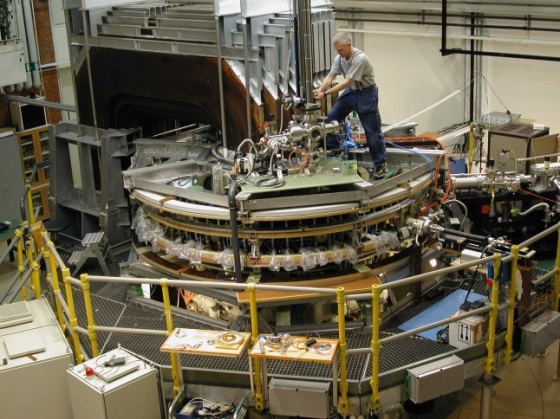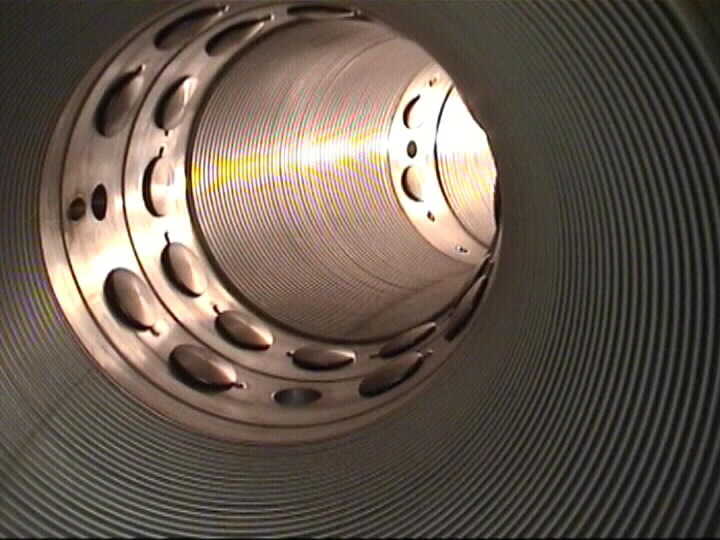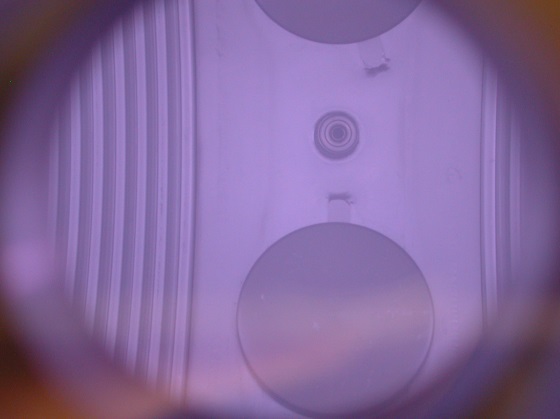Fusion Plasma Device EXTRAP T2R
The EXTRAP T2R device produces a high energy density ionized gas – plasma – utilizing the method of magnetic confinement. The plasma has multiple uses, such as research on magnetic confinement fusion, materials research, plasma waste treatment, and various plasma applications.



Application for fusion energy research
The main application of the EXTRAP T2R plasma device is research on magnetic confinement fusion. Research and development for fusion reactors aim at an environmentally acceptable and commercially attractive energy source with an almost infinite supply of fuel. The major difficulty is the extreme conditions that are required for a fusion reactor: the temperature of the fuel has to be ten times higher than that in the centre of the sun. The goal-oriented approach of European fusion energy research is outlined in the Roadmap document “Fusion Electricity – A roadmap to the realisation of fusion energy” which serves as the scientific/technical basis for the EU effort in fusion. A main topic of the fusion research carried out at the EXTRAP T2R device is control of plasma instabilities. The device has been regularly upgraded and modified over the past years. The most significant upgrade has been the installation of a state-of-the-art plasma instability control system, utilizing arrays of active magnetic field coils, enabling front-line .
Technical plasma applications and material research
The EXTRAP T2R device produces a hot and dense plasma that can be utilized also for basic plasma science, research on space plasmas, investigation of technical plasma applications, or plasma based material research. Possible technical applications include plasma based waste treatment, plasma generators for surface treatment, e t c. The device has excellent capabilities for material studies, which are not yet fully utilized. There are a number of access ports, through which material samples can be introduced into the plasma edge. Translation systems for insertion and extraction of material samples are available, also enabling in-vacuo transport of samples for post-exposure analysis elsewhere. Several ion beam based analysis methods are available through our collaboration with the Tandem Accelerator facility in Uppsala University .
Technical data
The plasma in EXTRAP T2R device is contained in a ring-shaped chamber with volume of 0.8 m3. The chamber has a number of access ports enabling insertion of material samples or various types of probes. Typical plasmas are produced from hydrogen gas with particle (ion, electron) densities of the order of 1019 particles per m3. Plasma particles have a thermal energy distribution characterised by a temperature in the range 100-500 eV. The particle flux at the plasma boundary is of the order of 1021 ions/m2 s. Plasma electrons produce a heat flux at the plasma boundary of the order 10-100 kW/m2 s.
Access and user support
Access to the EXTRAP T2R device is available to interested research groups. Due to the complexity of the facility, operation of the EXTRAP T2R device is necessarily a collaborative effort involving trained lab engineers and technicians. The scientists conducting a research project on the device will work closely together with the technical and science support staff at the division of Fusion Plasma Physics. New projects are welcome. The goal is that initiation of a project should be a straightforward process. Anyone with an interest in visiting the lab, receiving more information about the experimental facility, or to explore the possibility of starting a research project is encouraged to contact the lab director, see contact information below.
Users
The main user base for the EXTRAP T2R device are fusion research groups in Sweden. On the national level, the EXTRAP T2R device is also utilized for research training in the fusion science. The fusion research conducted at the device includes international collaboration with groups at Consorzio RFX (Padova, Italy), Univ. Wisconsin-Madison, (Wisconsin, USA), Columbia University (New York, USA), and Academy of Science Institute of Plasma Physics (Hefei, China).
Operation and governance
The operation and maintenance of the EXTRAP T2R device is the responsibility of the Division of Fusion Plasma Physics at KTH. The facility is part of the research infrastructure of the Swedish Fusion Research Unit, and as such receives financing from Vetenskapsrådet (VR).
Swedish fusion infrastructure steering committee members:
- Göran Ericsson, Uppsala University
- Pär Strand, Chalmers
- Per Brunsell, KTH
- Johan Öijerholm, Studsvik Nuclear AB
Contact
Per Brunsell is the lab director for EXTRAP T2R.
Visiting address
Teknikringen 29, KTH Campus:
